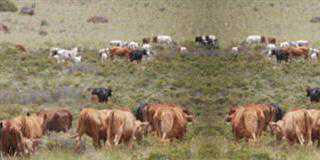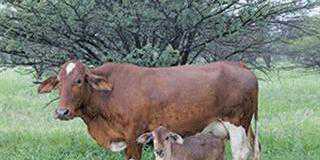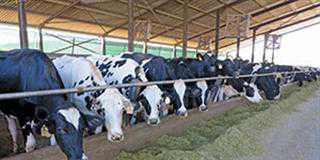“IF YOU NEED TO FIX A PROBLEM in your herd, start with the cows,” stresses Howard Hobson. Howard and his father Pip own Santapine Santa Gertrudis Stud on Pinekloof in the Ladybrand district of the Free State. They’re the breeders of SP 98 0024, the Farmer’s Weekly-ARC Best Elite Cow in the Santa Gertrudis breed for 2010. This is Santapine’s second Best Elite Cow award, the first being in 1993. Pip inherited the farm from his father in 1980.
At the time it was mainly a dairy enterprise, supplying milk to Maseru, while a few commercial beef cows produced oxen that were marketed at three years. Pip inseminated the cows with Santa Gertrudis semen and was very impressed with the results, as the Santa crosses were outperforming the others. In 1981 he established a Santa Gertrudis stud with registered Santas from Santahill in Dordrecht. He went to buy bulls, but came back with five three-in-one cows (pregnant, and each with a bull calf at foot). When they calved, all the calves were heifers, and that was how the stud started.
Another top Santa Gertrudis
For Pip and Howard Hobson the success of a herd doesn’t lie with the bull, but with the genetics of the cow. This point of view won them the Farmer’s Weekly-ARC Best Elite Cow of the year award. Wayne Southwood spoke to them about their breeding tactics.
“IF YOU NEED TO FIX A PROBLEM in your herd, start with the cows,” stresses Howard Hobson. Howard and his father Pip own Santapine Santa Gertrudis Stud on Pinekloof in the Ladybrand district of the Free State. They’re the breeders of SP 98 0024, the Farmer’s Weekly-ARC Best Elite Cow in the Santa Gertrudis breed for 2010. This is Santapine’s second Best Elite Cow award, the first being in 1993.
Pip inherited the farm from his father in 1980. At the time it was mainly a dairy enterprise, supplying milk to Maseru, while a few commercial beef cows produced oxen that were marketed at three years. Pip inseminated the cows with Santa Gertrudis semen and was very impressed with the results, as the Santa crosses were outperforming the others.
In 1981 he established a Santa Gertrudis stud with registered Santas from Santahill in Dordrecht. He went to buy bulls, but came back with five three-in-one cows (pregnant, and each with a bull calf at foot). When they calved, all the calves were heifers, and that was how the stud started.
Award-winning stud
At the age of 11½ years, SP 98 0024 has had 10 calves – five bull calves and five heifers – at an average inter-calving period (ICP) of 369 days. All her heifers have been retained in the herd, while three bull calves have been sold and two are still on the farm. She’s not Santapine’s only star. Two of the stud’s bulls have represented the breed in the Vleissentraal-ARC Special Performance Test Class, winning in 2003.
One of its bulls received a Bayer-ARC Platinum Award in 2003. At the 2007 Santa Gertrudis National Championships, the cow Santapine Violin was the Breed and Interbreed Champion Cow. At the 2010 National Championships at the Royal Show in Pietermaritzburg, the Grand Champion Cow and recipient of the Gold Cup for Supreme Beef Cow was from the Santapine Stud. For three years Santapine bulls won the Breed Plan BLUP Bull of the Year award, and in 2008 Santapine Winslow came through as the overall champion of all beef breeds.
Quality not quantity
The Santapine Stud’s main breeding objective is to produce genetic prototypes for the commercial cattle breeder – a long bodied, medium-framed animal with a good topline, that walks well and will last on the veld and sire good weaners.The stud herd currently consists of 130 cows and, as it is being expanded, 30 replacement heifers.
The farm, Pinekloof, where half the Santa Gertrudis herd, the young bulls and 115 Holstein cows are run, totals 1 000ha. The other half of the breeding herd, as well as heifers being grown out, is carried on the 500ha farm Hoepelrok near Tweespruit, 40km away. A third leased farm supports a herd of 120 commercial cows. But Pip stresses that herds shouldn’t become too big as the focus is on quality, not quantity.
The average herd intercalving period (ICP) is 402 days. The cows are medium framed, averaging 550kg, and weaner calves average 288kg. The latter weight depends on seasonal conditions. At 20 months to 24 months, or 350kg to 400kg, heifers are artificially inseminated with imported semen or semen from top SA bulls to calve at 29 months to 33 months. A catch bull is put in six weeks later to serve those not conceiving with AI.
The heifers get no special treatment, but are grown out on the veld with a lick. If mated earlier, they don’t grow out very well and never become good cows, in addition to producing first calves that are too small. Cows are mated in single sire herds of 30 cows to 40 cows per bull.
The Hobsons grow maize and green feed. In winter dry Santa cows graze maize stover, stud weaner heifers graze green feed and hay and bulls are phase D tested to be sold at 28 months.The main calving season is from September to December and the second in March and April. Two seasons split the work load and give any late calvers that have bred well another chance.
Selling and culling
“Most cattlemen try to fix a problem in the herd by using the right bull. It will fix the progeny but the poor genetics will still remain in the cow,” warns Howard. By culling all the problem cows, they can now use practically any bull in the herd.Recently they sent two groups of weaners to a sale. The first averaged 248kg at seven months and sold for R16,30/kg liveweight.
The second batch, weaned at five months averaged 190kg and sold for R17,60/kg liveweight. In the commercial herd they try to sell at what the market wants, but won’t sell calves younger than five months.Their rule of thumb to determine the price of a commercial bull is that seven weaners at the going price should cover the price of the bull. For example, seven weaners of 250kg each at R12/kg = R21 000. Stud bulls, on the other hand, will sell for R30 000 plus.
Recently they sold stud bulls for R100 000.Howard remarks that many buyers are becoming interested in the polled factor in the Santa Gertrudis, due to easier maintenance and handling, and no need for dehorning. In the early 1990s Pip started focusing on the polled factor and for 12 years used only polled bulls, so that a very strong polled factor is present in the genetics of the Santapine herd.
Namibia is a very good market for the Hobsons and they have already sold 30 bulls there. They also sell bulls to Zambia and Botswana.In the past Santa Gertrudis bulls had excessively long sheaths. But Howard explains that for the past 15 years the breeders, under direction of recently retired breed director Martin Seyfferdt, selected against this trait and today’s Santas have excellent sheaths.
For more details contact Pip on 083 400 0521 or Howard on 082 410 2401 or e-mail [email protected]













